Learn how to make Fermented Hot Sauce – a simple way to enhance and preserve your abundance of garden chilies to use throughout the winter. Full of healthy probiotics, this easy recipe has many health benefits. Plus it just tastes good! Video.
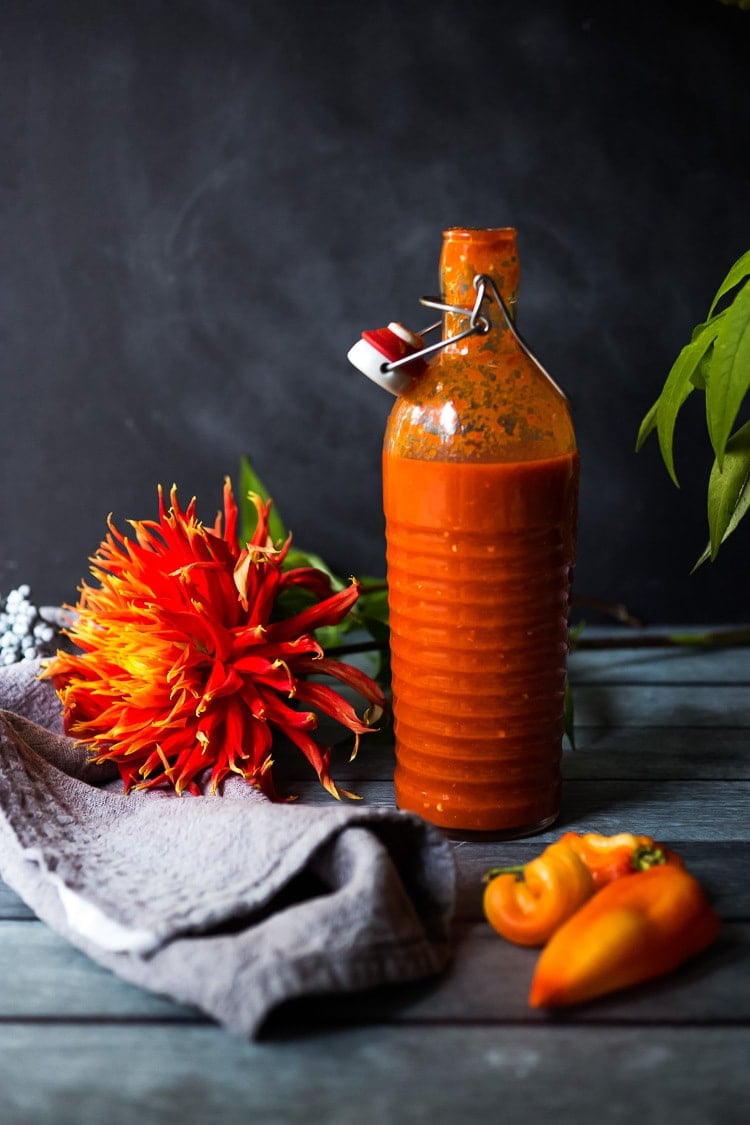
For many of you with gardens out there, this is the season of harvesting. Here’s a simple way to use all those chilies you’ve got growing out back and turn them into something that will bring you a little kiss of sunshine during the cold months – Fermented Hot Sauce! Now, before you feel intimidated – know that this only takes 20 minutes of actual hands-on time and no special equipment. It’s ridiculously easy!
Why I prefer fermenting over canning:
- Healthier: Fermentation creates “ALIVE” food- incredibly rich in probiotics. These good bacteria are living creatures that work with our microbiome to improve digestion, boost immunity, and prevent disease. Having a diverse microbiome is healthy! Canning “kills” all these healthy probiotics through the heating process.
- Taste: I prefer fermentation over “canning” because fermentation keeps these healthy bacteria alive, and as a result, the fermented food actually tastes better and better with time! Canning halts the development of flavor.
- It’s easier: Canning requires more hands-on time.
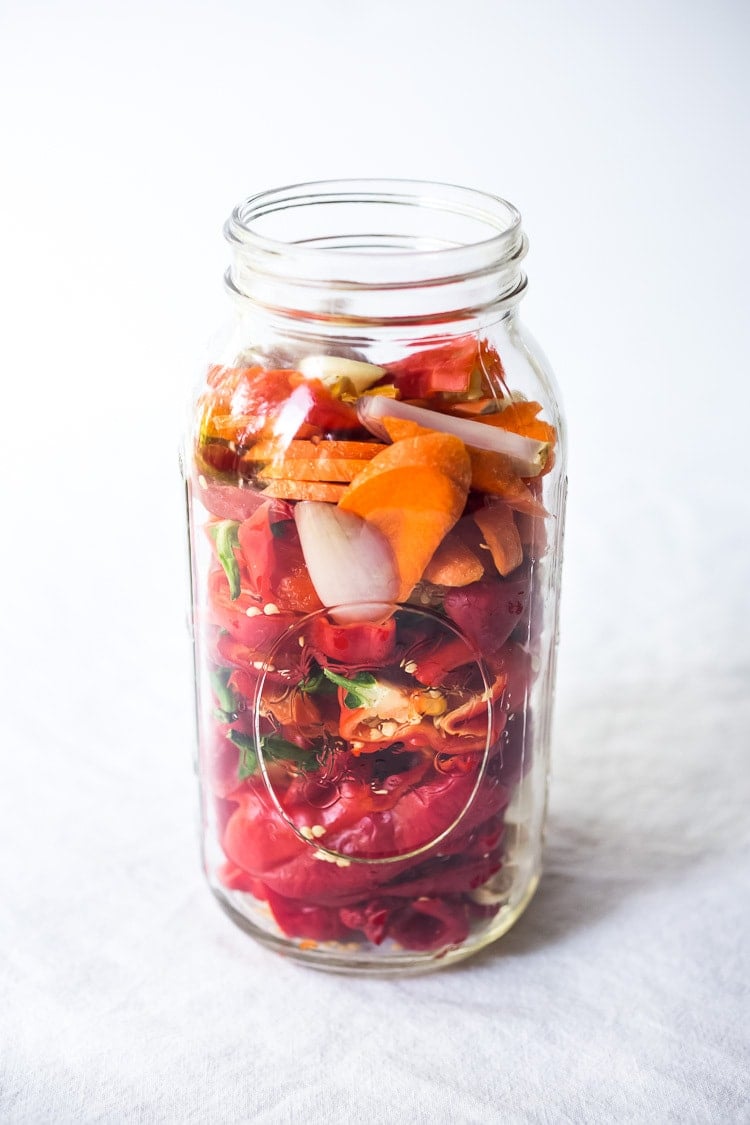
How to make Fermented Hot Sauce:
Step one: Fill a clean 2-quart jar with any type of fresh hot chili, onions, garlic and thinly sliced carrot. You can use bell peppers to temper the hot chilis if you want a milder version. Just stick with the same color palette so your fermented hot sauce stays colorful and vibrant.
In this recipe, I used Padrone Peppers, a Spanish variety that had turned red, which I found at our farmer’s market. But feel free to use any kind you want or a blend. You’ll need about 1 pound in total. (You can easily halve this recipe)
Step two: Make a saltwater brine, using 1 1/4 teaspoons fine sea salt, per 1cup of water.
Salt Ratio for Fermentation:
Having the right proportion of salt to water is important. Not enough salt may allow unhealthy bacteria to grow. Too much salt will kill all the bacteria and the chilies won’t ferment. If you need to add more water to the jar, then add salt accordingly.
Use 1 1/4 teaspoons fine sea salt per 1 cup of water. This is roughly a 3% Brine (3 grams of salt per 100g of water).
Here, I used 5 cups of water, so I added 1 1/4 teaspoon salt x 5 cups water = roughly 6 1/4 teaspoons of fine ground sea salt. Heating the water slightly helps the salt dissolve.
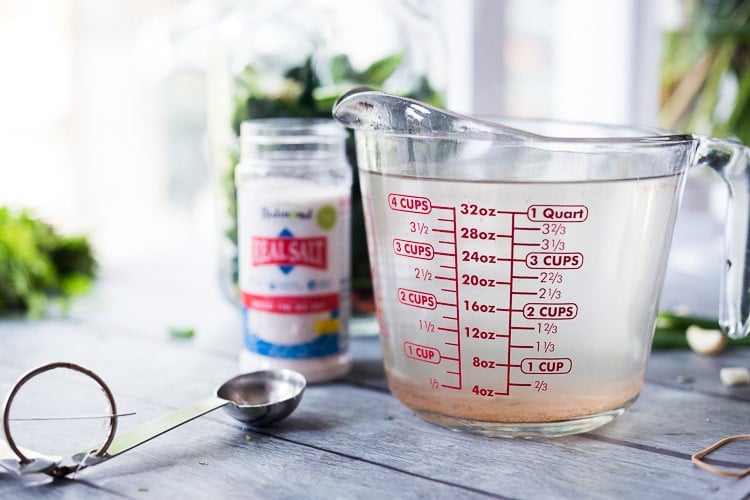
Step Three: Combine! Pour the brine over the chilies and push them down so they are completely submerged under the brine. Feel free to cover the chilies with a cabbage leaf to keep everything down, then weigh them down.
Step Four: Weigh down the chilies. You can use a fermentation weight, like this version that I really like, that will fit perfectly into a mason jar, to keep everything submerged. If anything floats to the top, and touches air, this can potentially mold, so either fish it out with a slotted spoon, or push it down under the brine.
Or in a pinch, a zip lock bag filled with water can be used as a weight, just place this over top. I prefer using a glass or ceramic weight.
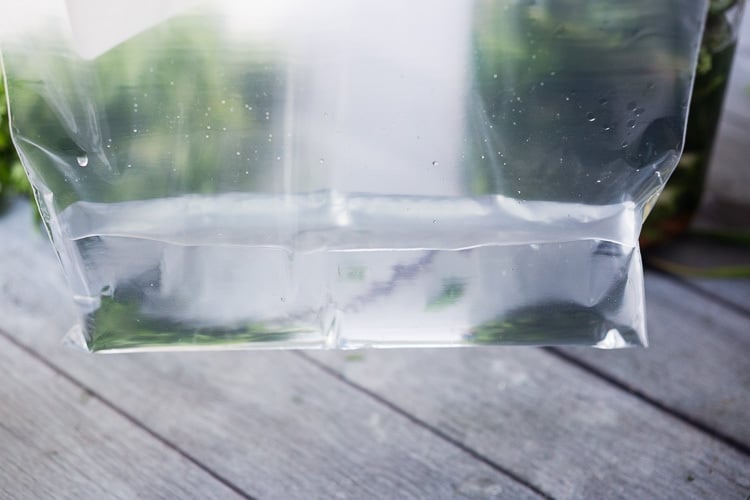
The water in the bag will work as the fermentation weight here. A small clean shot glass, placed over a cabbage leaf, can also act as a fermentation weight as well.
Here you can see I’m working on a mild green hot sauce which is in the fermenting phase still.
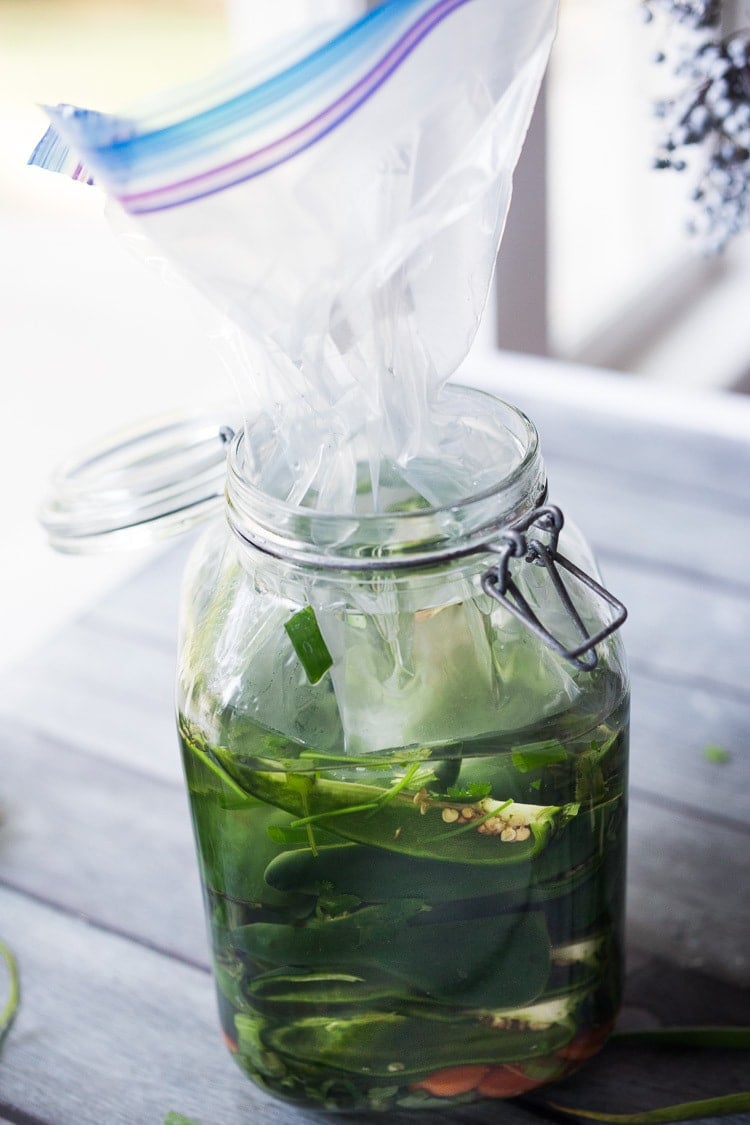
Step Five: Place a lid on top, leaving it loose. You want the fermentation gasses to be able to escape while keeping any creatures (bugs, flies) out. A couple of layers of cheesecloth also work here.
Step Six: Place the jar in a bowl or pan to catch any liquid that may spill over, and place it in a cool, dark place, like a basement. 65F-70F is ideal. If you don’t have a basement or a cool place, a lower cupboard in the kitchen is an option.
Check every few days, removing any “floaters”. After a few days, the brine will turn slightly cloudy, and when you tap the jar, you should see little bubbles float to the surface or some overflow on the pan- all signs of life!
Ferment 5-10 days. I usually go 7-12 days, long enough to soften those carrots, which you will be blending up in the sauce.
If, for some reason, you are going out of town, you can always place the ferment in your fridge, which will slow it down, but keep it alive, and you can resume when you get back.
Why is the Brine Cloudy?
Cloudy, tangy brine is a natural by-product of the fermentation process- a combination of lactic acid and yeast- and is the reason why they call it Lacto-fermentation.
Various strains of bacteria are present on the surface of all plants, especially ones growing close to the ground. Lactobacillus bacteria convert sugar into lactic acid, preserving the peppers.
Both salt and lactic acid prevent the growth of harmful bacteria. Over time, the cloudiness can settle out of the brine to the bottom of the jar. Some batches are naturally cloudier than others, but all are safe to consume.
A cloudy brine is a sign that you have a safe, successful, and tasty ferment.
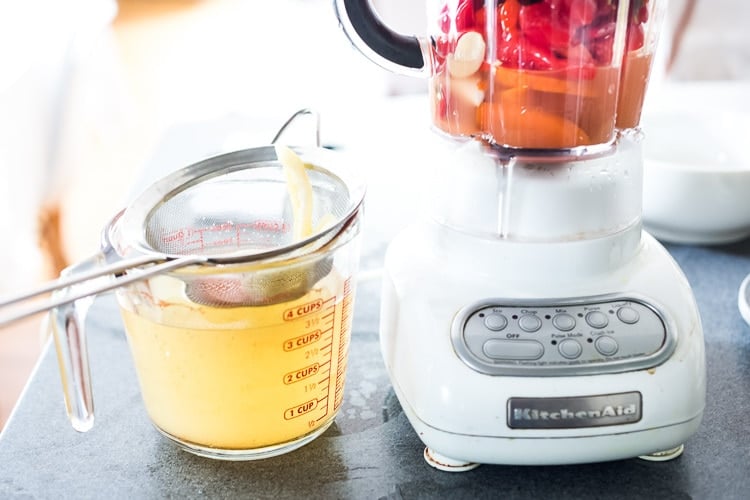
Step 7: Blend! Strain the brine, saving it. Add the strained chilies/carrots/garlic to the blender with one cup of brine and blend until smooth, a least a minute! At this point, you can add herbs (oregano or cilantro is nice here) and spices (cumin, coriander, chipotle). Add a little splash of Braggs apple cider vinegar if you like (this is optional but also full of healthy bacteria) and more brine to desired consistency.
If you like the idea Sriracha, you could also make it sweet by adding sugar or honey, and perhaps ginger. You could also add herbs.
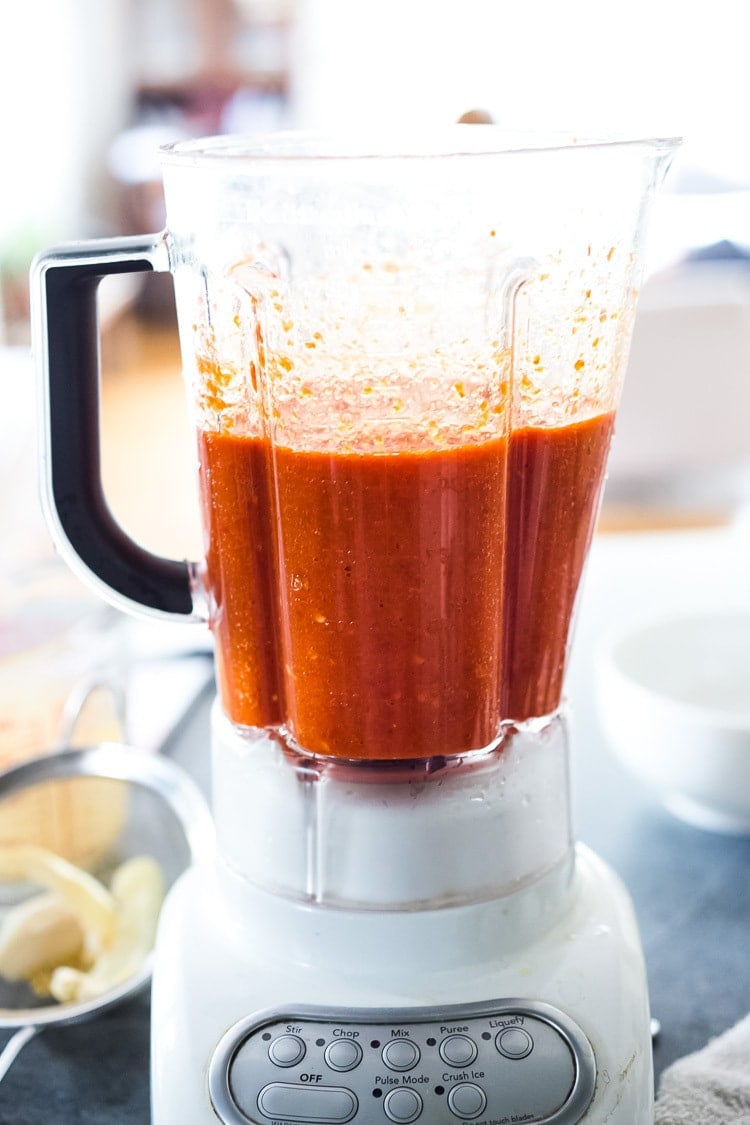
Step 8: Store! For everyday use, store the fermented hot sauce in squeeze bottles– leaving the tip off or open (or lightly closed) in the fridge. The hot sauce will continue to ferment in the fridge, and the open tip will allow the gasses out. Before using, cover the tip with your finger and give it a good shake.
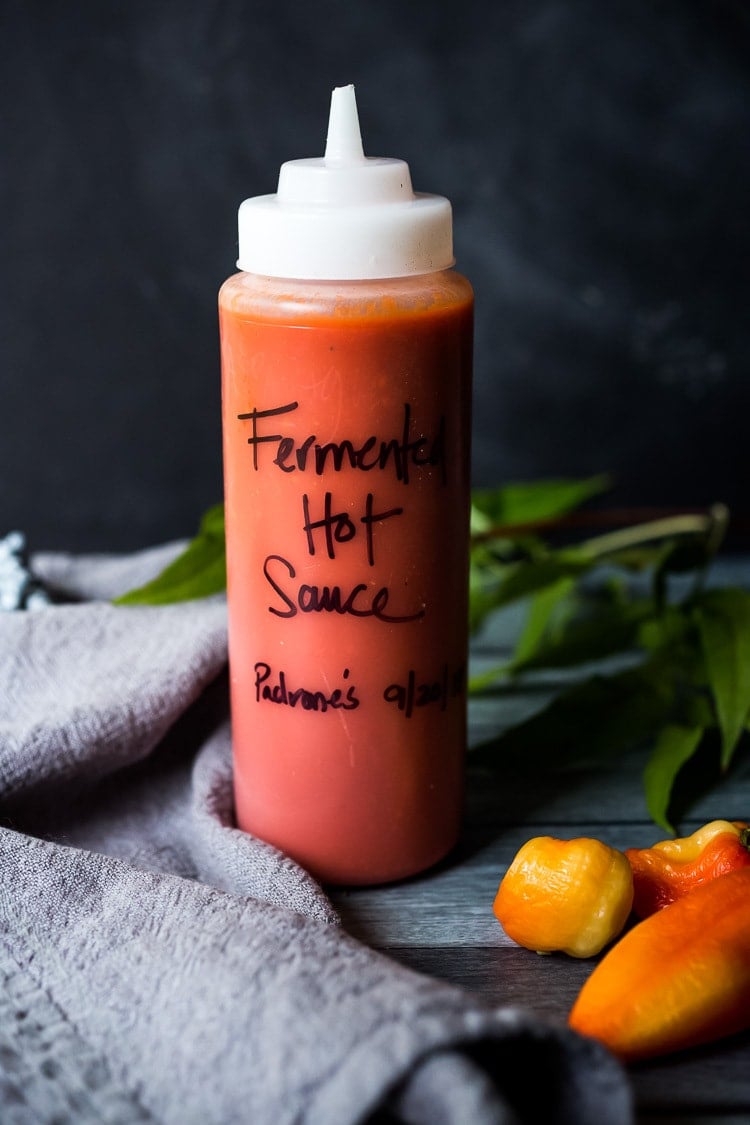
A little Warning!
If you place the fermented hot sauce in tightly sealed bottles, unrefrigerated, they will EXPLODE! This is because the hot sauce is still fermenting (producing gases) and will continue to create bubbles. Remember, it is alive, and this is NOT canning.
*If giving as a gift, yes, feel free to use a “cute bottle” but with instructions to refrigerate and loosen the lid.
But my hot sauce is way too hot!
Don’t be too alarmed if your hot sauce tastes overly hot when you first store it. After a week or two in the fridge, the gradual slow fermenting will substantially mellow out the heat! It’s quite surprising. Many times, I’ve made a hot sauce and tried it, thinking there was no way we would be able to eat it because of the heat level. But after a week or two, it really does calm down the heat. Fermenting the hot sauce gives it another layer of flavor, adding more and more complexity. This will keep indefinitely in the fridge.
Types of chilies to use:
Use any fresh chili pepper you like or a blend of different peppers (in the same color palate). To temper the heat, feel free to add similarly colored bell peppers (red, yellow, or green bell pepper). For example- add a golden bell pepper to habaneros to temper the heat. Or a green bellpeper to serano chilies.
Keep in mind you will be blending the sauce, so stick with the same color palate to make a vibrant-colored sauce. For example, mixing red and green peppers will yield a brown hot sauce- not the prettiest, but up to you. 😉
Also, keep in mind that fermentation will mellow out the heat of the peppers over time.
I am hearing that frozen peppers can be fermented ( please read the comments), but have not personally tried this.
Helpful tools
- Fermentation Kit (optional)
- Fermentation weights
- 2-quart mason jar (8-cup mason jar)
- Blender
- Strainer
- squeeze bottles
Making Fermented Hot sauce is a fun little project that only takes about 20 minutes of hands-on time. A lovely way to use up all the chilis in your garden (or a way to try out all the beautiful varieties at the farmers market) and a healthy way to bring more healthy probiotics into your life!
Mother Nature will do all the work for you! And after 5-7 days, you will end up with the most delicious, alive hot sauce that will get better and better with age!
Troubleshooting
- If there are no signs of fermentation, double-check you measured the salt ratio correctly. This is typically the most common problem (adding too much salt will halt the process and kill all the bacteria, even the good ones.).
- Try filtered water. Chlorinated water can halt fermentation.
- Do not over-wash or peel the peppers/carrots (for example, don’t use any type of produce soap) as the wild bacteria from the pepper skin, carrot peeling is what is starting the fermentation. I have the best luck with farmers’ market chili peppers and carrots because they are not over-cleaned or treated with anything.
- Mold: If your ferment has molded, something likely rose to the top of the jar and had contact with air. I would start over.
- Bad smell: the brine should smell tangy, garlic, and fresh, not “foul” in any way! If it smells “off,” it could be that salt was mismeasured or the ferment was contaminated: dirty hands, dirty utensils, dirty jar.
More Favorite Recipes!
- Yum Yum Sauce
- How to Make Kimchi!
- Simple Cabbage Sauerkraut
- Beet and Cabbage Sauerkraut
- Probiotic Gut Shot
- Curtido & Cultured Salvadoran Slaw
- How to make Fermented Pickles!
More from Feasting At Home
Watch HoW to make Fermented Hot Sauce!
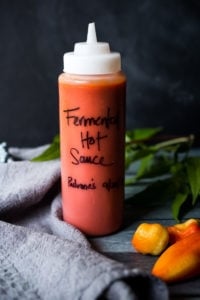
Fermented Hot Sauce
- Prep Time: 20 minutes
- Cook Time: 5 days
- Total Time: 120 hours 20 minutes
- Yield: 4 cups
- Category: Sauces, fermenting, preserving
- Method: fermenting
- Cuisine: American
- Diet: Vegan
Description
A simple, delicious recipe for Fermented Hot Sauce using fresh summer chilies, with no special equipment and only 20 minutes of hands-on time!
Ingredients
Saltwater Brine: ( 1 1/4 teaspoon salt per 1 cup of warm water) This is roughly a 3% Brine. (3 grams of salt per 100g of water)
- 5 cups filtered water
- 6 1/4 teaspoons finely ground sea salt (or Pink Himalayan salt) – use 1 1/4 teaspoon salt, per 1 cup of water.
- 2 Quart Mason Jar
Fillings:
- 16 ounces fresh chili peppers, sliced in half (about 6-7 cups) seeds & stem removed, see notes
- 1 carrot, very thinly sliced 1/16th-inch (do not peel!)
- 4–8 garlic cloves, cut into quarters
- 1–2 shallots, sliced (or 1/2 an onion)
After fermenting, add optional seasonings to taste. Keep in mind the “heat” will mellow with age.
- optional: herbs (oregano, cilantro, celery leaves) and spices (cumin, coriander, chipotle powder, smoked paprika)
- 1–3 tablespoons apple cider vinegar, (optional- for extra tang and for more healthy probiotics)
- honey or sugar to taste (optional, good if making Sriracha style)
- If your hot sauce is not hot enough, you can always add cayenne or ground chipotle to taste. Free free to add spices ( 1/2- 1 teaspoon) cumin, coriander, chipotle, allspice, etc. Make this your own.
Instructions
- Wash your hands, jar and ustensils. Not sterilized, just clean. 🙂
- Stir sea salt into the water until dissolved.
- Slice the small hot peppers in half, and remove stems and seeds if you like (for less heat). If your pepper are very hot, wear gloves. If adding bell peppers to temper the heat, cut into thin strips. Thinly slice the carrot (do not peel), slice the shallots, and slice the garlic.
- Layer all into a clean 2-quart mason jar. Top with a cabbage leaf to hold things down (optional) and pour the brine into the jar over the chilies, pressing them down under the liquid. If you need to add more brine, remember to use the ratio of 1 1/4 teaspoon salt per 1 cup of water.
- Weigh everything down with a fermentation weight (or use a small ziplock bag filled with water to weigh the veggies down or try a clean shot glass). You want the chilies completely submerged under the brine. Anything that touches air, may mold, so either spoon it out or push it down. Cover loosely with a lid ( or cheesecloth and rubber band) and place the jar in a pan or bowl to collect any liquid that may bubble over. The lid is loose here so gasses can escape easily, but no creatures can get in.)
- Place in a cool dark place, like the basement, 65-70F is ideal, (or the bottom cupboard in the kitchen) for 5-10 days or until signs of fermentation.
- On day 3-5: Check for fermentation: Tap the container and see if any tiny bubbles rise to the surface, check for a cloudy brine ( see notes) or check the bowl underneath, to see if there was any overflow. All signs of activity! Ferment 7-10 days, long enough to soften those carrots that you will be blending. And you can always ferment longer for even more flavor- I’ll often ferment 12 -14 days. Sometimes I’ll ferment 7 days, then place the jar in the fridge for a few weeks before blending. The longer the ferment, the tangier and more flavorful this will become, and the more mellow the heat. *If there are no signs of fermentation, give it a couple more days- then check the troubleshooting section in the post.
- After 7 days and signs of fermentation, strain and SAVE the brine. Place the fermented peppers, onions, garlic, and carrots into a blender and discard the cabbage leaf. Add 1 cup of the brine and blend until smooth as possible. This may take a couple of minutes. Add the vinegar if using, (and honey if you prefer a sweeter hot sauce like Sriracha), and more brine to desired thickness. At this point, you can blend in optional spices and herbs. ( 1/2-1 teaspoon spices, 1-2 tablespoons fresh herbs).
- Don’t be alarmed if it is overly spicy- the heat level will significantly mellow with time, as it continues to ferment in the fridge after 1-2 weeks. Place in a squeeze bottle and store in the fridge, leaving the tip open (or loose) for gasses to escape.
- Do not place in a sealed jar unrefrigerated– this will result in an explosion– and a great big mess- as the hot sauce is still alive and fermenting! BE WARNED! I have the best luck with using in squeeze bottles and leaving the cap off in the fridge.
- If transporting to a friend as a gift, it is ok to seal for short periods of time (a few hours) but make sure to tell them to refrigerate it and loosen the lid, very soon after receiving.
- The flavors will continue to develop and get more complex over time, the heat mellowing.
- To use, cover the tip of the opening with your finger and give a shake before using.
- This will keep up to 12 months in the fridge (probably even longer!).
Notes
WATER: Regular tap water may contain too much chlorine in it, inhibiting the fermentation process (although our tap water works fine). If fermentation is not happening, you may want to try filtered water.
SALT: I use fine ground sea salt or Pink Himalayan salt . If using coarse ground salt you may need to add a pinch more.
Peppers: Use any chili pepper you like or a blend of different peppers (in the same color palate). To temper, the heat, feel free to add similar colored bell pepper -substitute sweet red, yellow, or green bell pepper. Keep in mind, you will be blending the sauce, so stick with the same color scheme to make a vibrant colored sauce. For example, mixing red and green peppers will result in a brown hot sauce– but up to you. 😉 Also, keep in mind, the fermentation will mellow the heat a little. Removing the seeds will help temper the heat.
RATIO: If you need more water to cover or fill the jar, use 1 1/4 teaspoon salt per cup of warm water.
You could easily halve this recipe or use two, quart-sized jars.
CLOUDY BRINE: A cloudy brine is a natural by-product of the fermentation process-a combination of lactic acid and yeast and is the reason why they call it Lacto-fermentation. It is a sign of fermentation. Various strains of bacteria are present on the surface of all plants, especially ones growing close to the ground. Lactobacillus bacteria convert sugar into lactic acid, preserving the peppers.Lactic acid prevents the growth of harmful bacteria. Over time the cloudiness can settle out of the brine to the bottom of the jar. Some batches are naturally cloudier than others, but all are safe to consume and taste delicious. A cloudy brine is a sign that you have a safe and successful ferment.
Signs of fermentation: liquid overflowing into the bowl (check the bowl to see if the jar overflowed, a good sign! Tiny bubbles rising to the top when you tap the jar. Cloudy brine, tangy flavor or smell.
Nutrition
- Serving Size: 1 tablespoon
- Calories: 4
- Sugar: 0.4 g
- Sodium: 112.3 mg
- Fat: 0 g
- Saturated Fat: 0 g
- Carbohydrates: 0.9 g
- Fiber: 0.2 g
- Protein: 0.1 g
- Cholesterol: 0 mg
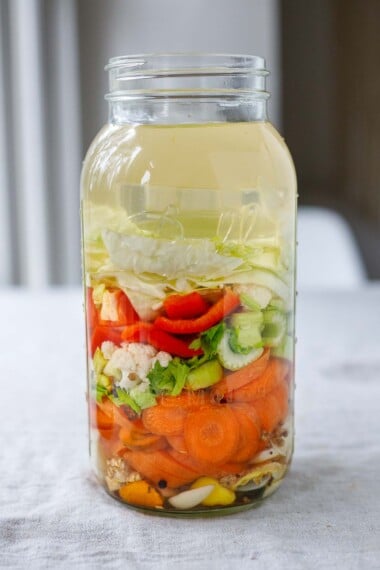
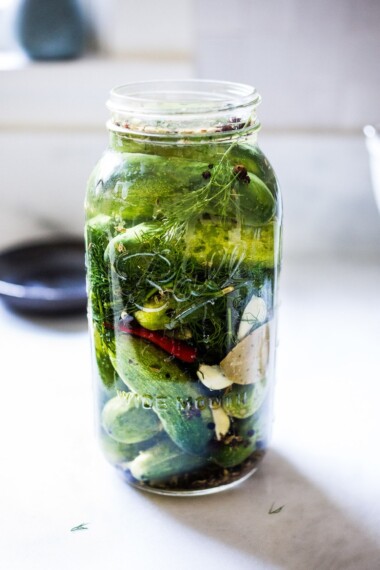
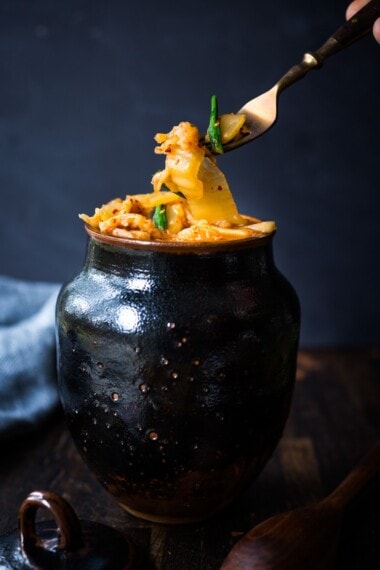
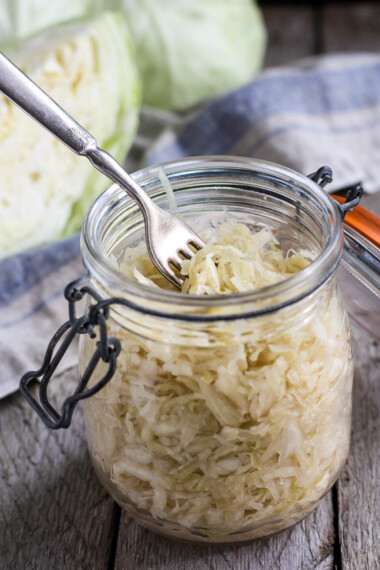


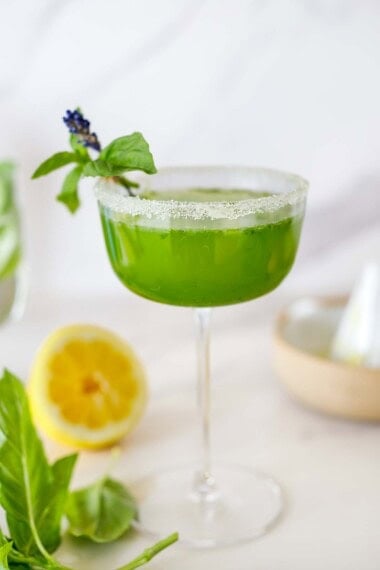
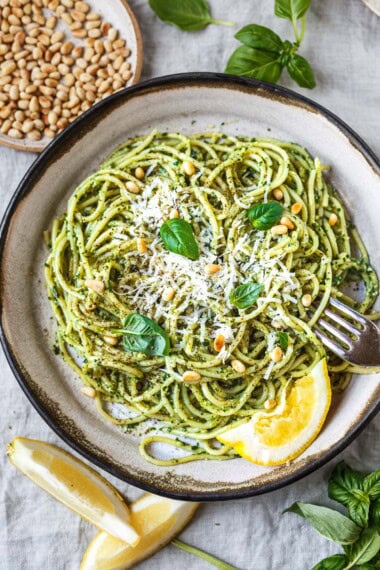

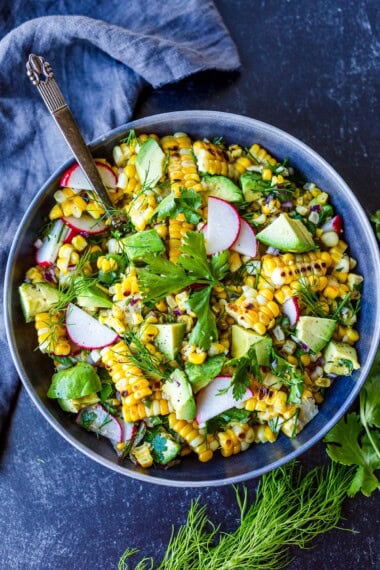
Hi, can you ferment the chillis with green mango ?
Hi Sid- I don’t see why not- but haven’t personally tried this! Sounds great to me though. 🙂
Worked fab with mango
Ok, great to hear Sid! I am trying that next! I bet the sweetness is nice, 🙂
Peach also works nicely.
That sounds good too Ernie!
Hi, what peppers did you use (the red ones)? Just curious. Thanks:)
Hi Arch- I used padrone peppers that turned red. They were the perfect heat. They are harder to find!
I am excited to give this a go, is there a reason why the lid needs to be off/loose for this one but not the other fermentation recipes here?
hey David- For all the fermentation recipes we have here, including this one, all the lids are kept a little loose, to allow air to escape, from the bubbling action.
I just did a 6 month ferment of jalapeños from our yard. Second year in a row using this recipe. I don’t add *anything* — just the peppers with vinegar and a little brine to taste. So good. Curious to hear how it went with frozen/dried peppers. We’ve gotten no chiltepin this year, so that might be my only route.
Glad you are enjoying it. I didn’t have luck with the dried peppers. I may try again.
Great recipe! Just made my first batch last week. Will definitely be making more!
Awesome Jennifer!
Wondering if you think a glass flip top bottle would allow for enough off gassing?
I’m not sure Tarra? When closed, they are pretty airtight- especially with the rubber ring. So I hesitate. You want the gasses to be able to escape. You could experiment- check it after 1-2 days and see what you think? Stand back. 😉
I’ve been fermenting for almost 25yrs. Gasses is what fermenting is creating. The Gasses have to escape while keeping dirt, dust, critters etc etc out of the vessel. Whatever vessel is used must have a lid that fits our in your case the flip top with the river flat washer as that bottles seal. Leave the flip top hanging and use aa poured off tshirt cotton or coffee filter, or like the author advises “cheese cloth” (but make the cloth holes are small enough to keep the containment out of the btl!) Then rubber band that filter on the neck of your bottle….
Thanks for the recipe! Have you had any luck fermenting dried peppers?
Hi Susan- I personally have not great luck here, but others have tried I think. I couldn’t get mine to ferment with just the dried. I have added a few dried peppers to the already fermenting peppers though, like on day three, and that worked fine.
Great recipe. This is the second time I’ve used it. Great results.
thanks Rich!
I really wasn’t a fan right off the bat when tasting it on it’s own. I added a bit too much ginger when fermenting and it was REALLY showing. I struggled with the consistency and mine is still not coming right out of a squeeze bottle, but that little bits are actually alright. I still don’t think it is all that on it’s own, but as soon as it is combined with literally anything it is the best hot sauce I’ve ever had and who eats it on it’s own anyway? In addition it was tons of to make and super simple. I’d never fermented anything before, but this went perfectly.
Glad you are enjoying this! The little bits will soften after time, and the hot sauce will get even better. 😉
I’ve had this recipe going for a week & a half. It smells good & the brine is a little cloudy, but I see no signs of fermentation, no bubbles & there’s been no overflow. Should I just let it sit for a while longer or throw it away?
It actually sounds pretty good- cloudy and good smell are good signs. Are there tiny bubbles when you tap the jar? Does it smell tangy at all? It’s hard to tell without seeing it, but if you can sense any tanginess – either taste a few drops or by smell, then I bet it is fine. 😉
Thank you for your response, no bubbling or bubbles & all I can smell is the garlic & onions. But I’ll let it sit for a while yet & see what happens.
Thanks for this recipe, Sylvia. I’m wondering if you’ve found a use for the leftover fermenting brine. It seems a shame to toss it.
Thanks Janalyn- I use it in soups, to give a little kick.
I’m in love with how this turned out! Just put all the ferment in the Vitamix after a week and it is delicious!! What a great way to use up all the peppers and carrots from our garden at the end of the season.
Glad you gave it a go!
Shoot, I jumped the gun and put my cilantro and spices in with everything that’s going to ferment. Is this going to totally kill it?
Hey Bryan, it should be just fine!
Just a quick question.
Does the cap on the sqeeze bottle stay off indefinately or until after a certain period of time?
Thanks
I usually keep the cap off, but you could lightly place one on top if you like. 🙂
Hi! I have finished the ferment and am about to blend. Regarding your note about fridge storage and leaving the cap off; how long does the cap or lid need to be off/ajar? In other words, I’m guessing it wouldn’t need to be for the whole 12 months it’s in there? It wasn’t clear in the directions, and I don’t have a squeeze bottle, so I just wanted to clarify. Thank you so much!!
Gotcha Victoria- the lid doesn’t need to be off, just loosely screwed on for any off-gassing. 😉
Thank you!!
I love this recipe and have made it a couple of times. This afternoon I forgot to let the water cool down (thinking I had the recipe in my head by now), and poured very hot brine on top of the peppers. WHAT WILL HAPPEN NOW? Have I ruined my first batch? Why does it need to be room temp? Thanks!
Hi Harriett- it still may be ok. I guess in my mind, I thought the hot water may damage the wild bacteria on the peppers-so I thought to let it cool first. But at this point, I would just try it and see?
We’ll know more later! Hopefully there is enough airborne bacteria in the house to compensate. I left the lid off for a few hours til the jar cooled down, then put a fermenting lid on it and put it in the pantry. I think it will be ok! Thanks for your timely response!
Thanks- let me know how it turns out!
After five days the surface of my brine is covered with a white bubbly layer. Is this in the category of “cloudy brine?”
Shoot Sara, tt is hard to tell without seeing it. If it is cloudy in the brine itself, that is ok, but if it is like a layer of mold where it hits the air, then not ok. How does it smell? Can you smell mold- it would be pretty distinct.
It smells like vinegary and peppery. It doesn’t have any other smells, although I’m not sure what mold would smell like.
Further googling makes me think it might be Kahm yeast.
Then it is probably Kham yeast, which is not harmful. Mold smells “moldy”. 😉 It’s hard to miss!
The recipe says to remove seeds from the chiles, yet video shows what appears to be whole chiles with seeds and stems being added to recipe. which is correct?
Either way works. for less spicy, remove seeds.
Getting ready to pick my first batch of jalapenos and Hungarian hot pepper. Would it be ok to also add celery and cauliflower along with
the carrots and onions?
It would almost be like a giardiniera sauce which is pretty popular in Chicago.
Yes, I think that would be tasty! just be sure to cut small so they soften and can be easily blended!
Anyone suggest a really good blender? I used my ninja blender and it turned this into a very fine chutney in brine, not really a ‘sauce. I blended for a LONG time as well and the very fine chutney in brine is the best my ninja can do. Otherwise, tastes great
I love our Vitamix (or Blendtec is a good sub)!
I recently followed this recipe with jalapeno, serrano and garlic. I have a fermentation crock with weights that I use and it turned out amazing. I let it ferment for 7 days which was just perfect for my tastes. Thanks for the recipe, I look forward to the next batch, I’m thinking same recipe but with some of the peppers getting smoked first.
Perfect Jed! It is a fun one! Adding Smoked peppers sound really tasty, but make sure there are fresh peppers in there too- smoking may kill the healthy bacteria needed to ferment. You could maybe blend those in after fermenting?
I hadn’t thought about adding them in later. Great suggestion. Knowing that when working with smoked stuff, a little goes a long way, I was planning on only smoking about a quarter of the peppers. I also plan on reusing my leftover brine, figuring there would be a lot of healthy Lacto to aid in the fermentation.
Is there a possibility to use blueberries or strawberries?
I don’t see why not? Try it!
Very good, thank you! I have people waiting in line for this stuff.
Fun to make and delicious.
Awesome Ernie! So happy you are enjoying.
I love this recipe, would like to make with some fruit. Would that be ok?
And also what kind of fruit.
Yes, you can add fruit. Mango, pineapple, peaches would work great.
Ok I am going to risk it, smells great and tastes amazing
Now my question is, how long can I keep the brine? It has an amazing flavor that I can see adding to many dishes ….
Awesome Dori! Maybe you did put the right amount of salt in?! You can keep the brine indefinitely once refrigerated. It is perfect for adding to soups and other dishes. 🙂
I made this once before and it was amazing. Have a another batch going with an airlock, one week in. Now I’m second guessing if I did the salt right. How can I tell? If I did get it wrong I likely skimmed the recipe and only used 1 1/4 teaspoon total, which would be a pretty big miss
I have lots of bubbles. Haven’t opened yet as I left the seeds in and don’t want air getting in. Any advice?
Shoot, Dori! I understand your predicament. The salt amount here is pretty important. If you use too little harmful bacteria can grow. Could you add more salt and airlock again? I’m not sure- I hate wasting – but don’t want anyone to get sick either.
Darn. So I won’t be able to tell? I was hoping smell and or visual mold would be a way to tell if it failed?
Yes, Visual mold would be an indicator- not sure about the smell though- possibly?